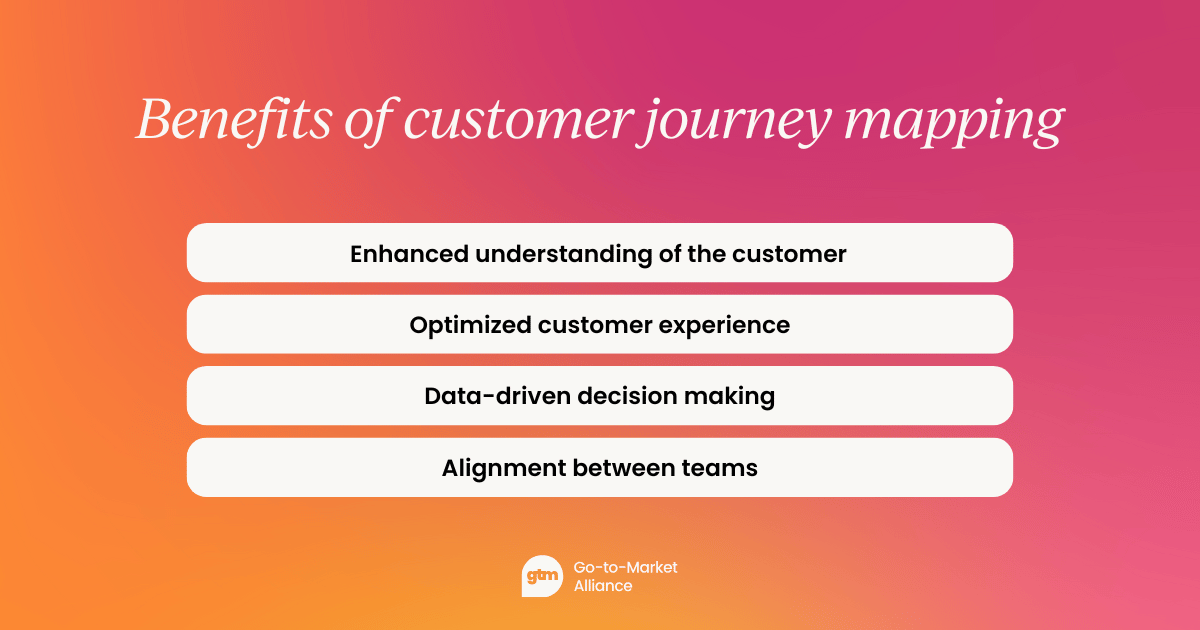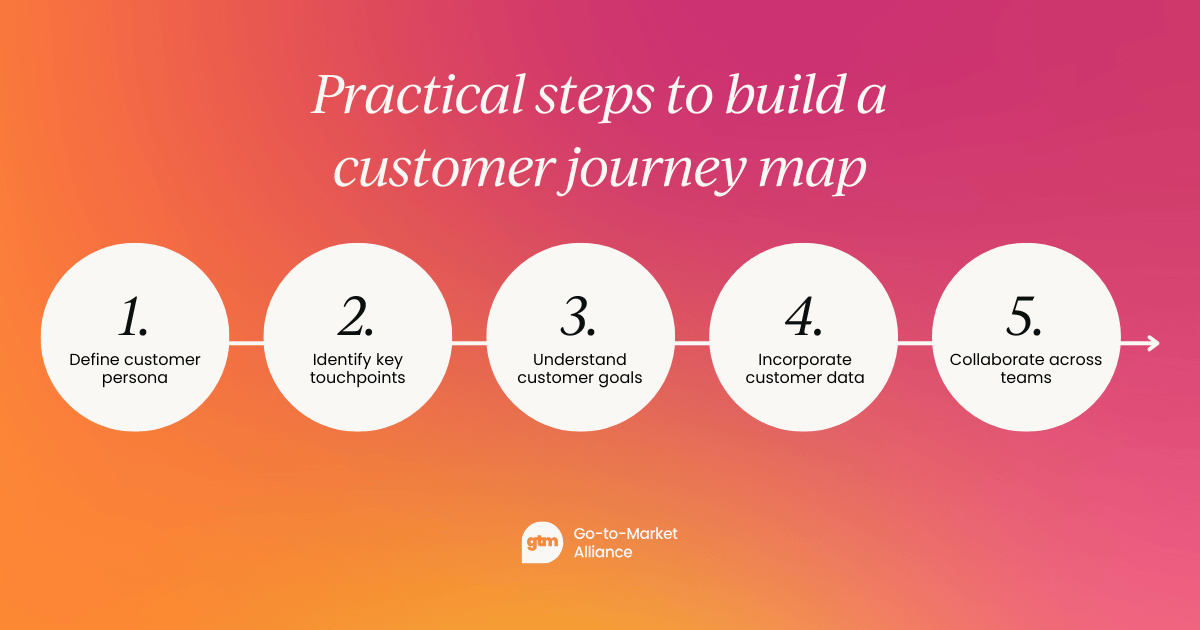We've all encountered useless personas that force you to decide whether your customer is a cat person or a dog person. While subjectively entertaining, these details rarely offer any real strategic insight.
This article isn’t about that.
This is about taking a practical, data-driven approach to understanding your customers and how they interact with your brand.
In today’s market, where customer experience is often the key differentiator, having a well-mapped customer journey is essential for building effective marketing and go-to-market (GTM) strategies.
Whether you’re a marketing expert or a GTM leader, understanding each customer touchpoint is crucial. It can not only shape your tactical execution but also form the foundation of your broader strategic vision.
Because a good strategy isn't just a plan—it's about leveraging deep customer insights to make informed decisions that drive growth and innovation. This is why strategy matters, and journey mapping is one of the most powerful tools to inform and refine it.
But first, what is strategy?
Before diving into the role of customer journey mapping, it's crucial to define strategy. Strategy is the high-level, usually long-term, plan that outlines your business's goals and the path you'll take to achieve them.
It’s about making deliberate, informed choices based on your market position, customer needs, and competitive landscape. It answers the "what" and "why" of your business:
What do you want to accomplish, and why is this direction the most advantageous for achieving your long-term objectives?
Many get strategy confused with tactics and this distinction is important. Tactics are the specific actions and steps you take to execute your strategy. They’re the "how" and "when"—the day-to-day activities that drive campaigns, nurture leads, or improve customer service.
While tactics are essential for bringing your strategy to life, they are only effective if they align with a well-defined strategy.
A successful strategy combines insights, resources, and objectives into a cohesive plan aimed at sustained growth. For marketing and GTM teams, this might involve identifying and targeting the right market segments, determining how to position your product uniquely, delivering value that resonates with your audience, and optimizing revenue streams.
But how do you gather the insights necessary to craft, refine, and adjust your strategy effectively?
That’s where customer journey mapping comes in. It provides the data and context needed to inform strategic decisions, helping you understand customer motivations, preferences, and pain points.
In essence, journey mapping turns abstract strategic goals into practical, customer-centric plans that guide both high-level strategy and tactical execution.
What is customer journey mapping?
Customer journey mapping is a visual representation of a customer’s end-to-end experience with your brand. It covers every interaction—from the moment a potential customer becomes aware of your brand, through consideration and purchase, to post-purchase engagement.
Mapping the customer journey allows you to uncover critical insights by laying out every touchpoint where customers interact with your brand.
This holistic view enables brands to understand how customers move through their decision-making process and highlights pain points that can be optimized for a better experience.
The strategic benefits of mapping the customer journey
Before we dive into how to map the customer journey, let's take a look at some benefits of this process.

1. Enhanced understanding of the customer
Mapping a customer journey forces your team to walk in the customer’s shoes. This builds empathy for your target audience and allows you to refine your personas based on actual behaviors and needs rather than assumptions.
These insights directly feed into your strategy by helping you identify:
● What motivates customers at different stages
● What challenges they face that your brand can address
● How they prefer to interact with your company
For example, mapping may reveal that customers drop off at a specific touchpoint due to confusion or lack of trust. By understanding this, you can strategize how to mitigate these concerns through better education, messaging, or design.
2. Optimized customer experience
Your strategy should be rooted in optimizing the customer experience (CX). A seamless, enjoyable journey is a key driver of loyalty and advocacy.
Mapping the journey uncovers friction points that might otherwise go unnoticed, such as lengthy onboarding processes, inconsistent communication, or poor post-purchase follow-ups.
By identifying these pain points, you can adjust your strategy to focus on creating smoother transitions between each stage of the customer journey. An optimized customer experience not only increases satisfaction but also helps you retain customers and increase lifetime value.
3. Data-driven decision making
Customer journey maps provide an abundance of actionable data. Once you understand customer behaviors, motivations, and pain points, you can start making data-driven decisions about your marketing and GTM strategies.
This data helps inform:
● Which channels are most effective for reaching and converting customers
● What content or messaging resonates best at different stages of the journey
● Where to allocate resources for the greatest impact
With a data-backed understanding of the journey, you can focus your efforts on the highest-value touchpoints and optimize your marketing spend for the best return on investment (ROI).
4. Alignment between teams
One of the biggest strategic advantages of journey mapping is its ability to align your teams—especially marketing and sales.
Marketing needs to attract leads, and sales need to close them. But when teams are disconnected, customer experiences suffer due to mixed messages or inconsistent follow-ups.
Mapping the customer journey allows teams to see the entire process, creating alignment on key goals, messaging, and metrics. This unification ensures that every customer touchpoint—from first awareness to final sale and beyond — is strategically orchestrated for success.

How customer journey mapping enables strategic innovation
Gathering insights
The process of customer journey mapping provides insights that form the backbone of your strategic planning.
At the highest level, it reveals what your customers truly need and expect, helping you define the overarching direction your business should take. This understanding enables you to make strategic decisions about your target market, positioning, and value proposition.
This strategic decision could then influence everything from product development to partnerships and pricing models. By basing your strategy on concrete insights about customer behavior and preferences, you ensure that every aspect of your business aligns with what matters most to your audience, giving you a competitive edge.
Additionally, journey mapping highlights where customers experience the most friction, guiding strategic choices about resource allocation. If you find that customers frequently drop off during a particular phase, your strategy might involve investing in technology or training that addresses this gap.
By refining your broader strategy with insights from the customer journey, you ensure that your marketing, sales, and operational efforts work cohesively toward your long-term business goals.

Uncovering issues
Strategically, journey mapping helps you identify fundamental weaknesses that could threaten your market positioning.
For instance, if your map reveals that customers struggle to find relevant information during the decision phase, it may signal a need to reposition your brand as a thought leader in the industry. This insight might inform a strategic shift to emphasize educational content and a value-focused approach in your GTM strategy.
Rather than merely addressing the tactical elements of friction points, journey mapping encourages a strategic rethink of how your business operates and engages with customers. This makes journey mapping an invaluable part of, for example, an ecommerce Go-to-Market strategy, where competition is fierce.
If customer support emerges as a critical pain point, the response might not just be adding more customer service agents; it could involve repositioning your brand as one that prioritizes customer empowerment, perhaps through self-service options, community support networks, or AI-driven solutions.
This shift in strategic positioning can redefine your brand’s identity in the market and drive lasting loyalty.

Fostering innovation
Strategically, customer journey mapping is a catalyst for innovation, prompting you to rethink how your brand meets and exceeds customer expectations. The insights derived from journey mapping can reveal emerging needs or trends, enabling you to make strategic decisions about future investments and product roadmaps.
Innovation at the strategic level often means redefining your market approach or even creating new market segments. By understanding where your customers find the most value—or where current solutions fall short—you can set a strategic vision that differentiates your brand in the market.
For example, if mapping shows a demand for more transparency in pricing or process, you might strategically decide to adopt a radical transparency model, positioning your company as the most customer-friendly option in your industry.
This strategic direction then guides all subsequent tactical actions, ensuring they align with the broader vision.
In short, journey mapping doesn’t just help you optimize touchpoints; it provides the insights needed to craft a robust strategy. It helps you decide what your company should stand for, where it should invest its resources, and how it should position itself in the market to drive long-term growth and differentiation.
Practical steps to build a customer journey map
In this section, we're not diving into those simplistic personas where you're left deciding if your customer prefers cats or dogs.
This is about building a journey map that drives strategic direction and actionable insights, ultimately informing how you engage with your audience. Here’s an approach to mapping the customer journey in a way that truly elevates your strategy:
1. Define your customer personas—the right way
Your personas need to be rooted in data and aligned with strategic business goals. Start by identifying key customer personas based on their needs, goals, behaviors, and challenges.
This foundational step informs not only the journey mapping but also your overall strategic positioning in the market.
For example, if one of your personas values convenience over everything else, your strategic focus might shift toward becoming the most accessible option in the industry.
Understanding these deeper motivations helps you decide how to position your brand, tailor your offerings, and allocate resources effectively.
2. Identify key touchpoints with strategic implications
List every touchpoint where customers interact with your brand, from marketing emails and social media to in-store experiences and post-purchase support.
Each touchpoint is an opportunity to create strategic value. Are there touchpoints where you can differentiate your brand? Are there interactions that directly tie to your long-term goals, like building loyalty or reducing churn?
By identifying and evaluating these touchpoints, you can strategically decide where to focus your efforts.
For example, if your strategy involves positioning your brand as the most customer-centric in the market, you'll need to prioritize and optimize support interactions.
Conversely, if your strategy is centered on product innovation, touchpoints related to product education and user feedback might take precedence.
3. Understand customer goals and pain points to shape strategic priorities
For each stage of the journey, dig deep into what customers want to achieve and what obstacles they encounter.
This isn’t just about optimizing individual touchpoints; it’s about using these insights to shape your strategic priorities.
Are customers seeking more information at the awareness stage? Is the decision phase plagued by unclear pricing or lack of trust?
These insights are crucial for guiding your overarching strategy. If your journey mapping reveals that customers are frustrated by long wait times for support, it may indicate that an investment in automated customer service tools or more robust support training is necessary.
If customers are struggling to find information during the consideration phase, a content-first strategy might be needed to establish your brand as an authority. Understanding these pain points at each stage allows you to craft a strategic roadmap that addresses core challenges, rather than just deploying tactical fixes.
4. Incorporate data to inform strategic decisions
Customer journey mapping should be data-driven, incorporating both qualitative and quantitative insights. Use customer feedback, behavior analytics, CRM data, and survey results to create an accurate and nuanced map. The real power of this data lies in how it can inform your strategic direction.
For instance, if the data shows that a majority of customers abandon their carts due to unclear return policies, this insight can inform a strategic shift towards transparency and trust-building.
You might then decide to overhaul your communication strategy to emphasize a hassle-free return process, aligning with a broader strategy of becoming the most customer-friendly brand in your market.
Incorporating real-world data ensures that your strategy is grounded in actual customer behavior and needs, not just assumptions.

5. Collaborate across teams to align strategy
Journey mapping isn’t just a marketing exercise; it’s a strategic initiative that requires input from sales, marketing, product development, customer service, and beyond.
Each team interacts with customers at different touchpoints, offering unique perspectives that can shape the customer journey map and, by extension, the strategic plan.
Involving cross-functional teams ensures that the map reflects real-world experiences and that your strategy is cohesive.
For example, insights from the customer service team may reveal recurring post-purchase pain points that could inform a shift in product development.
Similarly, sales might highlight key objections that customers have during the decision phase, helping you refine your market positioning. The ultimate goal here is to build a strategy that is not only customer-centric but also seamlessly integrated across every department in your organization.

Wrapping up
Mapping the customer journey is far more than just a marketing exercise; it's a strategic imperative that can reshape the way your brand approaches the market. By diving deep into your customers' experiences, you gain actionable insights that inform not just your tactics but the overarching strategy that drives your business forward.
This isn’t about creating superficial personas or tweaking minor touchpoints; it's about using customer journey mapping to make informed, strategic decisions on how you position your brand, allocate resources, and innovate in response to real customer needs.






